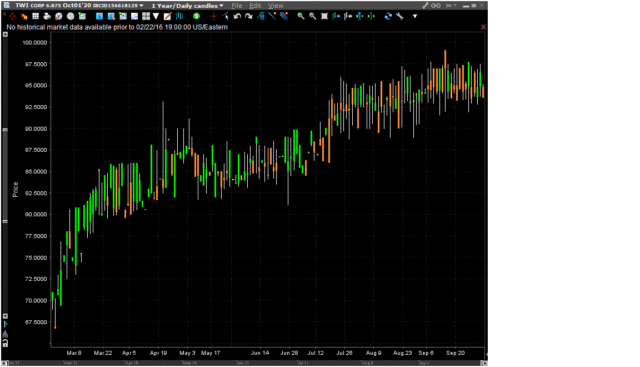I’ve been doing an exhaustive examination of the available publicly traded debt from US corporations. I am specifically looking for debt that has maturity lengths of between 2-8 years, and the underlying issuer is relatively solvent. The actual parameters I used for the screen I’ll leave aside, but there were a lot of issuers to do some quick research on to see whether they were worth further investigation.
The “relatively solvent” criterion allows me to exclude companies that are basically operating entities that are encumbered with a gigantic amount of debt relative to tangible book value. These entities typically exhibit goodwill and intangibles far in excess of what the stated equity is, which means that the entity was likely a result of a previous leveraged buyout or some sort of financial restructuring to extract the maximum capital of the entity.
A good example of this is Toys R Us, a completely leveraged mess of a financial entity as a result of a leveraged buyout years ago. If you like anti-depressants, please take them while you read their last quarterly report. I would not go anywhere near their unsecured debt. Somehow this entity actually warrants a market value of an 11% yield to maturity on their 2-year debt. Amazing.
I am not interested in these entities unless if they were generating a sufficient amount of cash in relation to their debt, and in most cases they do not. This means that refinancing risk is going to be crucial for these entities – while today they might get the financing, tomorrow they might not. It is at those moments where an investor will make the optimal risk/return ratio. Today an investment will just result in a mediocre risk/return.
There were a lot of offshore drillers that are clearly in trouble, and a lot of energy-related entities in trouble. In general, I am not interested in these (in addition to having enough exposure to energy bonds via Teekay debt).
Finally, anything that did seem to be a reasonable candidate had a chart resembling this:
I picked Titan International (NYSE: TWI) just as an example and not something I am interested in purchasing (at current prices). It is an automobile parts manufacturing company and is fairly easy to analyze – $200 million cash in the bank, a $60 million debt issue due in January 2017 that they will pay off, and $400 million due October 2020 (which you see in the chart above). The coupon is 6.875% and the debt is senior secured, and trades at a YTM of about 8.5% at present. The corporation in the first half of this year generated about $11.6 million in free cash flow. Historically they seem to be a cash generation vehicle for management teams.
It doesn’t take a Ph.D in finance to realize that they will likely have to refinance the debt when it comes to maturity in four years. They will probably be able to do this, but who knows?
This same bond traded at nearly a 19% YTM back in February when the whole market was going haywire.
Just because the bond is trading at higher levels (lower yields) doesn’t mean that they are valuable today. But if you did buy today you’ll get a high single digit return in the compensation for the risk that you’ll be dealing with the Chapter 11 proceedings of an auto parts manufacturer that doesn’t have the capacity to generate a huge amount of cash in a very low-margin industry.
Is it worth 19% to take this risk? Absolutely. Is it worth 8.5%? Probably not. Today you can get that debt for about 94 cents on the dollar, but if you got the same debt for 80 cents a year from now, you will get a much better return (assuming the aforementioned default does not occur).
The other question I ask myself is whether we’ll likely see something in the next couple years that will resemble a bond refinancing crisis. While the future is always difficult to predict, there will always be something that will cause panic in credit – and it is in these times that one must dive in deep, just like I did back in January and February.
There are numerous examples like this littered in the bond markets today – lots of mediocre companies with bonds trading at single digit yields to maturity. Even worse are the over-leveraged messes that are just asking for recapitalization when the market sneezes.
So overall, the pickings of my bond market research have been very slim.
The results are quite depressing – out of looking at approximately a hundred issuers, I’m only interested in doing a deep research session on one corporation. Also, my initial take on this entity wouldn’t be for their debt – it would be an equity investment. My initial instinct says that their equity could double in a year, while their debt yields 7.6%. I’m eager to start the research process.
Looking at this whole exercise, I realize this following statement might be the biggest piece of confirmation bias about my own portfolio, I believe the pieces of corporate debt that I currently own represents the best risk/reward available on the publicly traded markets today. I just don’t see anything else out there worth putting capital in the corporate debt markets. It’s a classic case of doing a lot of work but achieving no tangible results for the portfolio.
